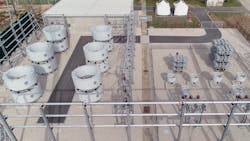ELES and HOPS installed seven compensation devices, four variable shunt reactors, two static VAR compensators, and a mechanically switched capacitor with a damping network.
In Slovenia, ELES installed:
- Static synchronous compensator (STATCOM) rated at +/- 150 Mvar in 400/220/110 kV in Beričevo substation.
- Variable shunt reactor rated at –150 Mvar and a mechanically switched capacitor with a damping network and capability of + 100 Mvar in 400/110-220/110/35/10 kV Divača substation.
- Variable shunt reactor rated at –150 Mvar in 400/220/110 kV Cirkovce substation.
In Croatia, HOPS installed three devices:
- Variable shunt reactor rated –100 Mvar at the 220/110/10 kV Mraclin substation.
- Variable shunt reactor rated at –200 Mvar at the 400/220/110 kV Melina substation.
- Stationary compensation device with static VAR compensation SVC technology rated at –250 Mvar at the 400/220/110 kV Konjsko substation.
Installation of these devices and the implemented virtual cross-border control center (VCBCC) with the advanced algorithms for Volt VAR Control (VVC) optimization to maintain acceptable voltages and the reduction of system losses achieved the goal of voltage profile control and the possibility of voltage regulation in the electricity systems of both Slovenia and Croatia. Furthermore, this innovation by ELES and HOPS also introduced an entirely new form of joint voltage regulation of both transmission systems. As a result, these compensation devices have contributed to improving network stability during emergencies. Moreover, their operation’s effects have already positively impacted the transmission systems of neighboring countries.
Battery Systems
Two battery energy storage systems (BESS) based on lithium-ion cells were installed in Slovenia to increase the flexibility of active power and, thus, the reliability of the system operation. BESS will also facilitate the transition to future electricity systems where the production of electricity from dispersed renewables and the active participation of prosumers in the energy market will prevail.
The battery energy storage systems are divided into two 5 MW units installed in Slovenia in the existing 110/35 kV Pekre and 400/110 kV Okroglo substations. They have a total active power of 10 MW and a nominal capacity of 50 MWh, ranking these BESS installations among the largest installed in Europe. Therefore, including these systems in the operation of ELES provides a powerful tool for addressing modern challenges in the electricity system — not only in Slovenia but in the broader region
Dynamic Line Rating
Power lines traditionally have a pre-set thermal power rating that enables the safe operation of the transmission grid. This thermal rating has a fixed value and should allow for safe operation in all weather conditions and loading of the lines. However, the actual thermal rating is highly affected by local weather conditions (outside temperature, loading of the line, wind, etc.) and is usually higher than the pre-set rating. Advanced smart grid solutions allow real-time monitoring of local conditions on the lines, thus enabling better grid use. Increasing the transfer capacities with overhead line dynamic thermal ratings (DTR) is a smart grid technology deployed within the SINCRO.GRID project.
In Slovenia, ELES deployed a DTR system to allow real-time monitoring of local conditions on the overhead lines (OHL) and thus enable better and safer grid use. 31 weather stations were installed on ten power lines having the approximate length of 243 km (151 miles). Weather measurements were included in the weather processing system ONAP (Atmospheric Conditions Forecast Assessment) and augmented gridded weather data used in dynamic line rating (DLR). In Croatia, HOPS deployed the DTR on the three 220 kV lines (around 162 miles of lines) are covered with system and weather stations are installed on 15 towers.
Dynamic line rating (DLR) algorithms and models for the DLR system within these weather stations calculate the dynamic thermal limits of transmission lines for operation, thereby increasing the accuracy in terms of circuit loading of the real-time and short-term load forecasts. In addition, data from these weather stations improved the mesoscale weather data obtained from the Slovenian Environment Agency, thus reducing any uncertainties in calculations. The SUMO DLR system installed is entirely the result of Slovenian knowledge. ELES managed to attract leading Slovenian experts to participate in its development.
ELES and HOPS now use the results to improve the safety of operation and the transmission capacity of the network; hence, the existing infrastructure is used more efficiently. Furthermore, with the average 15% to 20% increase in transmission capacities, it is now also possible to transfer larger quantities of energy from renewable sources in southern Croatia to the energy markets in the region.
Virtual Cross-Border Control Center
ELES – HOPS Virtual Cross-border Control Center (VCBCC) was set up for coordinated and controlled centralized representation of RES production and system variables of the Slovenian and Croatian HV and MV networks to allow power system optimization in the whole control area. The VCBCC consists of numerous IT solutions that enable data acquisition from renewable energy sources providing improved observability of energy networks and more accurate estimation/forecasting of renewable energy sources production. This is the first case in Europe where neighboring transmission system operators have joined forces in regulating and optimizing the voltage in their transmission systems.
Additionally, advanced solutions were implemented at the control center. These include an IT platform for
- the integration of prosumers in ancillary services; a communication platform for operational data exchange between transmission and distribution system operators
- an upgrade of the metering system to support modern data exchange based on the latest standards
- an upgrade of the solar production forecasting tool and modernization of the ICT infrastructure.








